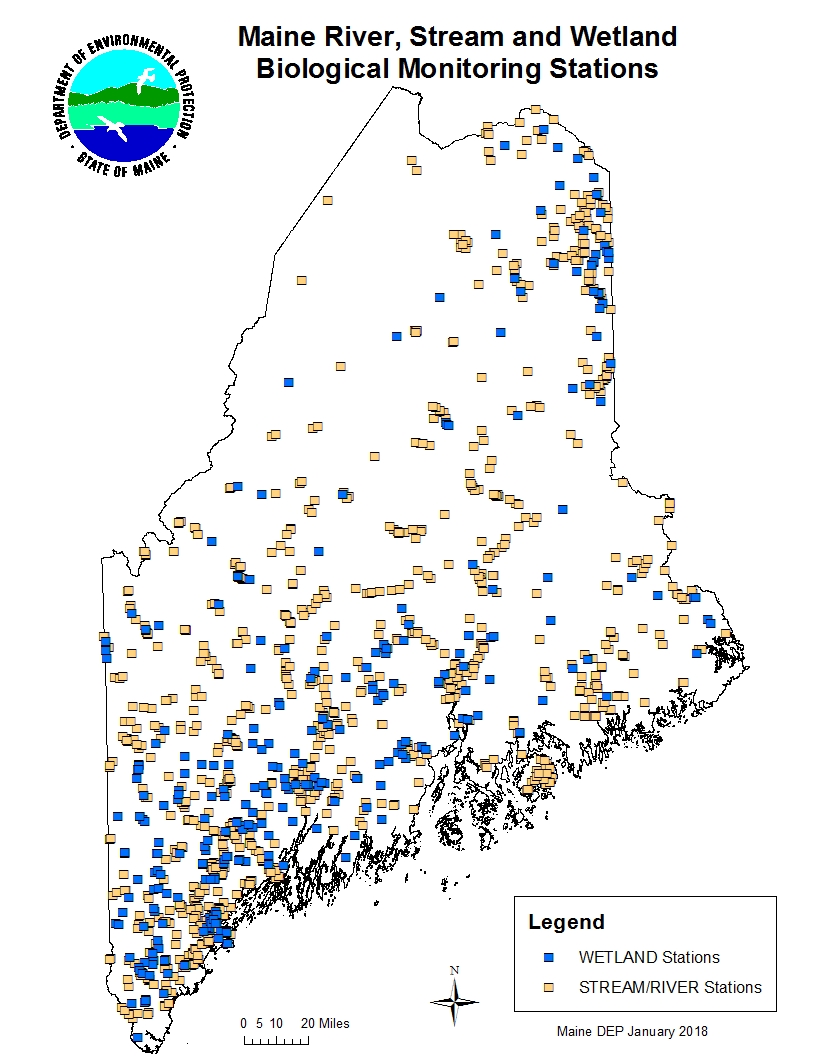Home → Water Quality → Monitoring → Biomonitoring → Sampling & Analysis
Sampling & Analysis
Overview
The Biological Monitoring Program evaluates the health of the State's streams, rivers, and wetlands and determines if they are attaining desired water quality goals. In 1986 the Maine State Legislature adopted Maine 's Water Quality Classification Program and assigned one of four classes (AA, A, B, and C) to every river and stream segment in the state. Wetlands associated with rivers and streams receive the same class. Each class has different environmental goals and criteria for determining if the goals are being attained. A major goal is to support healthy communities of aquatic life. The Biological Monitoring Program collects samples of macroinvertebrates (aquatic insects, crustaceans, mollusks, mites, leeches, and worms) and algae to determine if waterbodies are attaining aquatic life criteria associated with their assigned classes (AA, A, B, C).
Macroinvertebrates and algae are excellent indicators of water quality. The number of different kinds of organisms and the abundance of different groups provide information about a waterbody's health. Some species or groups require cold, clean water and natural habitats. Other species or groups can survive in warm, polluted water and degraded habitats. Since macroinvertebrates and algae live in bodies of water, they are exposed to environmental conditions over a period of time. The resulting communities of macroinvertebrates and algae reflect the overall health of a waterbody.
The Biological Monitoring Program has a long history of using macroinvertebrate data to determine if streams and rivers are attaining the aquatic life goals assigned to them. The Program uses a statistical model based on 26 variables, such as the number of different kinds of macroinvertebrates or the abundance of specific groups that require cold, clean water. The model predicts the probability of a stream attaining class A, B, or C criteria. The Biological Monitoring Program is currently developing similar models for macroinvertebrates in wetlands and algae in streams and wetlands.
The Biological Monitoring Program also collects data about surrounding land-use, habitat condition, and water chemistry at sites where macroinvertebrates and algae are sampled. This information is used to better understand the response of species to changes in water quality. The physical and chemical data are also helpful when determining how to restore an impaired waterbody.
The links below describe sampling and analysis for macroinvertebrates and algae in more detail. For more information on this subject please see the Biological Monitoring Program's Standard Operating Procedures, located on the Materials Page.
Algae Types Descriptions of the different kinds of algae.
Algae Sampling In Rivers & Streams Sampling and data analysis methods for algae in rivers & streams.
Algae Sampling In Wetlands Sampling and data analysis methods for algae in wetlands.
Macroinvertebrate Types Descriptions of macroinvertebrate orders.
Macroinvertebrate Sampling In Rivers & Streams Sampling and data analysis methods for macroinvertebrates in rivers and streams.
Macroinvertebrate Sampling In Wetlands Sampling and data analysis methods for macroinvertebrates in wetlands.
Click on a map to view a larger version (pdf file).

